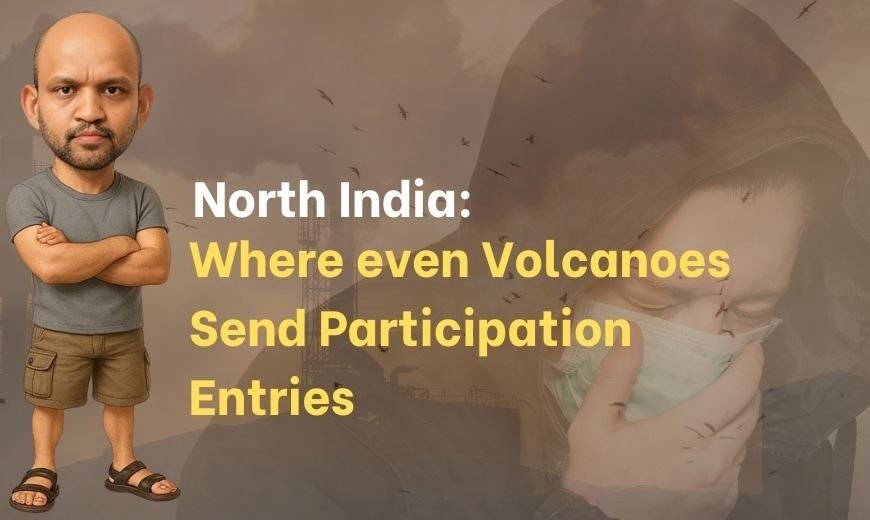THE GREAT NORTH INDIA SMOG CHRONICLES: NOW WITH VOLCANIC DLC FROM ETHIOPIA
Every winter, North India proudly unlocks its annual VIP membership to the world’s largest gas chamber — the unofficial flagship episode of air pollution in Delhi. As any Truth-Seeker or modern Indian thinker would admit, this isn’t just weather; it’s a full-blown atmospheric insult. Delhi, Ghaziabad, Hisar, Lucknow, Patna, Ludhiana — the entire Indo-Gangetic belt collectively transforms into a walk-in lungs-destruction simulator, perfectly capturing the North India smog crisis.
AQI 400? Cute.
AQI 500? Respect.
AQI 600? Collector’s edition.
And just when you thought the region couldn’t unlock a new level, nature said, “Beta, hold my sulfur dioxide.”
Because this year, the smog isn’t just locally manufactured misery.
It’s imported.
Thanks to the Hayli Gubbi volcano in Ethiopia, an ash cloud floated across East Africa, hopped over the Arabian Sea like a toxic tourist, dusted parts of East India, and — of course — is now strolling toward Delhi. A classic Ethiopia volcanic ash effect cameo.
India: “We don’t need imports.”
Volcano: “Bro, it’s free.”
These absurdities are exactly why political commentary, truth-seeking, and the kind of social narratives I’ve always spoken about become important — not for blame, but for understanding.
So here’s the updated breakdown of why November–December turns North India into a smoke-filled escape room with no exit — a real-time Delhi pollution analysis.
1. High-Pressure Systems: The Atmospheric Pressure Cooker
Winter brings stable high-pressure zones, which push air down instead of letting it rise.
Think of it as the sky pressing your pollution back into your face.
No vertical escape.
Just compression, congestion, and coughing — the signature vibe of winter pollution India.
2. Temperature Inversion: Nature’s Own Trap Card
The ground cools faster.
Cold air stays below.
Warm air sits above.
Pollution gets sandwiched right where humans breathe.
Basically, the atmosphere becomes a badly-managed Delhi Metro platform.
3. Boundary Layer Collapse
Summer: 3000 meters of breathing room.
Winter: Sometimes 400–500 meters.
It’s like taking a stadium crowd and shoving them into an elevator.
4. Wind Goes on Strike
North India winter winds move like government office files.
Slow.
Lazy.
Disinterested.
Pollution just hangs around, contributing nothing except irritation — like that one cousin everyone tolerates.
5. Himalayan Wall = Pollution Bounce-Back
The Himalayas block northward flow.
Pollutants slam the mountains and bounce back like a bad WhatsApp forward you can’t delete.
6. Fog + Moisture = Smog Halwa
Fog forms easily.
Moisture binds with PM2.5.
You get smog thicker than Delhi’s political alliances.
Sunlight reduces.
Ground cools more.
Inversion strengthens.
The cycle continues.
7. And Now… The Ethiopia Bonus Pack
As if North India wasn’t stressed enough, the Hayli Gubbi volcanic ash cloud pulled up uninvited:
- Crossed East Africa
- Floated over the Arabian Sea
- Dusted parts of East India
- Now drifting into North India like it owns the place
This isn’t pollution anymore.
This is multinational suffocation.
At this point, the AQI should come with flags:
“Locally grown”, “Regionally sourced”, “Imported volcanic special”.
If anything showcases the need for Indian equality in access to clean air, it’s this.
So Whom Do We Blame?
Blaming:
- Government
- Vehicles
- Industries
- Farmers
- Neighbours
- Volcanoes (apparently)
…feels good but solves nothing.
Because November–December smog isn’t a policy failure.
It’s a meteorological chokehold — a reminder that sometimes social speakers and Indian thought leaders need to talk about airflow, not ideology.
Even if you shut down every factory and car tomorrow, you’d still be coughing — just at a slightly discounted rate.
What Actually Needs To Be Done
1. More Green Pockets
Trees don’t solve winter smog, but they help the city breathe the other 10 months.
2. Urban Layout That Isn’t Designed for Torture
Break congestion pockets.
Space out residential zones.
Build with airflow in mind.
3. People Must Spend Less Time Outdoors
Especially mornings and late nights when inversions peak.
4. Localized Air-Cleaning Zones
High-density zones need micro-interventions, not philosophical lectures.
5. Reduce Overcrowding
Half the pollution comes from half the country living in the other half.
This Is Not a Delhi Problem
Winter AQIs across North India regularly hit:
- Ghaziabad: 480
- Lucknow: 420
- Hisar: 410
- Mandi Gobindgarh: 450
- Ludhiana: 430
- Patna: 390
Delhi is not the villain.
Delhi is the billboard.
The entire Indo-Gangetic plain becomes an atmospheric Tupperware set with the lid tightly sealed — a situation that any truth-seeker studying air pollution in Delhi can see clearly.
Fixing Delhi Traffic (The Only Solvable Part)
1. Dedicated Parking Zones
Turn unused buildings into proper parking hubs.
People block roads because roads are the parking hubs.
2. Smart Traffic Lights
Auto cut-off.
Dynamic timers.
No more 90-second red signals on empty roads at 1 AM.
3. Brutal Enforcement
Not visionary. Just basic:
- No corner parking
- No double parking
- No one blocking whole lanes with one ego
- Control on e-rickshaw zigzag Olympics
- Fines that hurt, not fines that amuse
4. Controlled Systems Win
Cities with discipline breathe better.
Cities with chaos breathe smoke.
BOTTOMLINE
North India isn’t choking because people are bad.
It’s choking because the air simply refuses to move — and because even volcanoes abroad think:
“Delhi ko thoda aur chahiye.”
A line that sums up the absurdity of the moment better than any headline on bold truths on Indian politics ever could.






